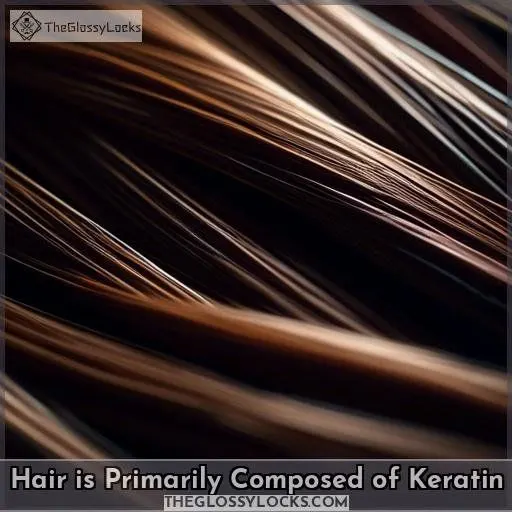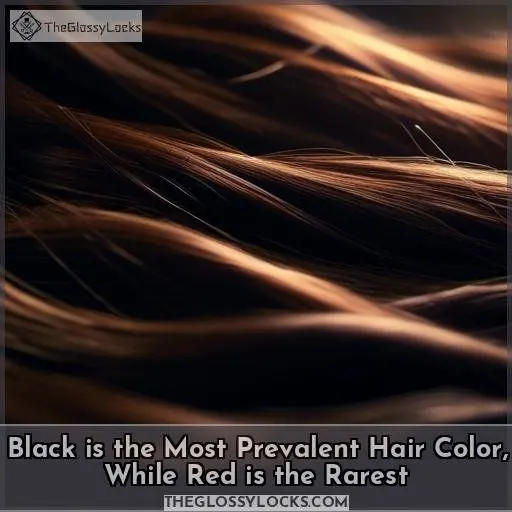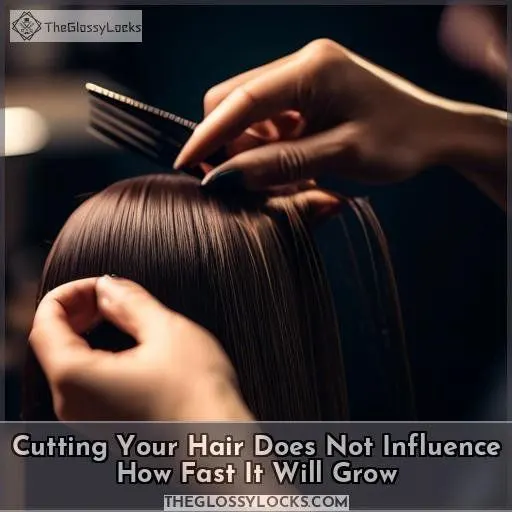This site is supported by our readers. We may earn a commission, at no cost to you, if you purchase through links.

Your hair is a remarkable structure, primarily composed of keratin proteins.
Did you know that warm climates may accelerate your hair’s growth due to increased circulation?
Intriguingly, when wet, a single strand can stretch up to 30% beyond its normal length.
Though the visible hair is actually dead, the follicles and scalp skin are very much alive.
Hair color, ranging from the prevalent black to the rarest red, holds clues about your ethnicity and geography.
Forensic experts even utilize hair to uncover essential facts in criminal investigations.
Delve deeper, and you’ll discover more fascinating truths about your luscious locks.
Table Of Contents
- Key Takeaways
- Hair is Primarily Composed of Keratin
- Warm Climates May Accelerate Hair Growth
- A Wet Strand of Hair Can Stretch Up to 30% of Its Normal Length
- All Hair That We Can See is Dead
- Black is the Most Prevalent Hair Color, While Red is the Rarest
- Hair Contains Important Information That is Used as Forensic Evidence in Trials
- Each Strand of Hair Can Support Up to 100 Grams of Weight
- Hair is the Second Fastest-growing Tissue in the Body
- Blow Drying Alters the Shape of the Hair by Changing Their Hydrogen Bonds
- Cutting Your Hair Does Not Influence How Fast It Will Grow
- Frequently Asked Questions (FAQs)
- Conclusion
Key Takeaways
- Hair is primarily composed of keratin proteins, which provide strength and resilience, and its growth can be influenced by factors such as diet, stress, and genetics.
- Warm climates may lead to increased hair growth due to improved circulation, but excessive heat can also damage hair, necessitating a balance between stimulation and protection.
- A single strand of hair can stretch up to 30% of its normal length when wet, showcasing its elasticity, which is important for overall hair health and appearance.
- Hair plays a significant role in forensic science, as it can contain traces of substances from a person’s bloodstream and provide valuable genetic information for investigations.
Hair is Primarily Composed of Keratin
Your hair is primarily composed of a protein called keratin, which is responsible for its strength and resilience. This protein is produced by hair follicles, which are located in the skin.
The structure of your hair is a complex system of cells, with the outermost layer known as the cuticle, followed by the cortex, and the innermost layer known as the medulla.
To maintain the health and growth of your hair, it’s vital to comprehend the science behind it. Keratin production can be influenced by various factors, including diet, stress, and genetics.
By understanding the role of keratin in your hair, you can make well-informed decisions about hair care and treatment. Remember, taking care of your hair isn’t just about appearance, but also about maintaining its health and ensuring it grows at a healthy rate.
So, next time you’re considering a hair treatment, reflect on the science behind it and how it will affect your hair’s keratin production.
Warm Climates May Accelerate Hair Growth
Warm climates may accelerate hair growth due to increased circulation and activity levels. The heat can stimulate the scalp, leading to faster hair growth. However, excessive heat can also cause damage to the hair, such as dryness and brittleness. It’s crucial to maintain a balanced approach, ensuring the hair is well-hydrated and protected from the sun’s harmful UV rays.
A Wet Strand of Hair Can Stretch Up to 30% of Its Normal Length
Your hair may be more elastic and flexible than you think! When your hair is wet, it can stretch up to 30% of its normal length. This is due to the hair’s unique anatomy, which includes a cuticle, cortex, and medulla. The cuticle provides a protective layer, while the cortex contains the hair’s pigment and gives it its strength. The medulla is the innermost part of the hair, which is less dense and provides a cushion for the hair shaft.
Hair elasticity and malleability are essential for its overall health and appearance. Hair extensions and hair products can help enhance these properties, making your hair look fuller and more vibrant. However, it’s paramount to be gentle with your hair, as over-styling or harsh treatments can damage the hair’s natural elasticity.
All Hair That We Can See is Dead
You might be surprised to learn that the luscious locks you see on your head aren’t alive. In fact, all hair that we can see is dead. This might sound strange, but it’s a natural part of the hair growth process.
Here are four interesting facts about your hair:
- Hair Follicles: The hair follicles in your scalp are alive, but the hair strands that grow from them are not.
- Scalp Skin: The skin on your scalp is alive, but the hair that grows from it’s not.
- Cuticle Layer: The cuticle layer of your hair is the outermost layer, and it’s responsible for protecting the hair from damage.
- Medulla Layer: The medulla layer is the innermost layer of your hair, and it’s responsible for giving your hair its strength and elasticity.
Despite being dead, your hair can still provide valuable information. Forensic scientists can analyze hair samples to determine past bloodstream contents, which can be instrumental in criminal investigations.
Black is the Most Prevalent Hair Color, While Red is the Rarest
Your hair color is a reflection of your genetics and the environment you live in. Black is the most common hair color worldwide, while red is the rarest, with only 1-2% of the population naturally sporting this vibrant hue. Hair color is determined by the amount and type of melanin in your hair, with black hair being rich in eumelanin and red hair having little to no eumelanin.
The popularity of hair dye has also influenced the perception of hair color. In the 1950s, only 7% of American women dyed their hair, while today, 71% of women feel more confident with dyed hair. The choice of hair color can be influenced by societal beauty standards, personal identity, and the chemistry of hair dye products.
Hair color can also provide insights into your ethnicity and geography. For example, people from eastern Asia and indigenous North/South Americans tend to have straight black/dark brown hair, while those from Africa have black coily/curly hair, and those from European countries have lighter colored hair ranging from straight to curly.
In terms of hair growth, it’s influenced by factors such as genetics, age, and overall health. For instance, as you age, your hair can’t make as much melanin, leading to grey hair and white hair. Certain health conditions can also affect hair color, such as stress.
Hair Contains Important Information That is Used as Forensic Evidence in Trials
Hair is an intriguing and multifaceted aspect of human biology, playing a critical role in forensic science. In the domain of forensic hair analysis, hair samples can provide essential information that may not be available through other means. Here are ten intriguing truths about hair that will leave you amazed:
- Forensic Hair Analysis: Hair analysis is a key tool in forensic science, providing information that other evidence may not be able to. It can answer questions about a person’s past, such as drug use or exposure to certain substances.
- Bloodstream Content: Hair can contain traces of substances that were present in the person’s bloodstream, providing a window into their past.
- Criminal Investigations: Hair evidence can be used to identify individuals, establish the extent of a crime scene, connect suspects to a weapon or crime scene, support witness statements, or even link different crime scene areas.
- Drug Testing: Hair drug testing involves collecting hair samples and analyzing them for traces of substances that may have been recently consumed, providing a temporal overview of drug use.
- Paternity Testing: Hair analysis can be used for paternity testing, as each strand has its own DNA.
- Medical Testing: Hair analysis is also used for medical testing, such as detecting nutritional deficiencies or monitoring therapeutic drug regimes.
- Poisoning: Hair can reveal traces of poisons that have been ingested, even if they’ve left other organs in the body.
- Race and Hair Treatment: Hair evidence can provide information about the race of the individual and whether the hair has been chemically treated or cut in a specific way.
- Genetic Information: Hair can contain genetic information such as blood type or DNA, which can be used for identification purposes.
- Hair Analysis Techniques: Hair analysis can be performed using various techniques, such as microscopic examination, DNA extraction, or comparing hair samples from different individuals.
These intriguing truths about hair demonstrate its importance in forensic science and its potential to provide valuable information that can help solve crimes and answer important questions about a person’s past.
Each Strand of Hair Can Support Up to 100 Grams of Weight
Just as your hair holds secrets that could unravel mysteries in courtrooms, it’s also a marvel of engineering with a surprising weight-bearing capacity.
Imagine this: each strand of your hair can support up to 100 grams of weight. That’s like hanging a small apple from a single piece of your hair without it snapping!
This incredible hair strength is all thanks to its tensile properties, a demonstration of hair’s endurance and resilience. The hair weight ratio is nothing short of astonishing, showcasing not just beauty but a remarkable capacity for load-bearing.
So next time you’re styling your locks, remember, you’re working with fibers that could rival some construction materials in strength!
Hair is the Second Fastest-growing Tissue in the Body
You might be astonished to discover that hair is the second most rapidly proliferating tissue in the body, only surpassed by bone marrow.
This implies that your hair follicles are continuously laboring to create new hair, which explains why hair loss can happen when hair follicles are compromised or cease functioning effectively.
To maintain healthy hair, it’s crucial to nurture your scalp, as it offers the vital nourishment and environment for hair growth.
Hair transplantation is a widespread remedy for people experiencing hair loss, as it entails relocating healthy hair follicles from one region of the scalp to another.
Therefore, bear in mind the importance of prioritizing hair care and scalp well-being to ensure that your magnificent locks continue to grow and flourish.
Blow Drying Alters the Shape of the Hair by Changing Their Hydrogen Bonds
Blow drying your hair can markedly alter its shape and appearance.
The heat from the dryer ruptures the hydrogen bonds within your hair, causing it to become more pliable and easier to style. This is why you might notice that your hair looks different after blow drying compared to when it’s air-dried.
However, this process can also lead to hair damage if not executed correctly. Excessive use of heat styling tools or chemical straightening treatments can weaken the hair, making it more vulnerable to breakage and split ends.
Additionally, humidity can influence how your hair appears. High humidity can cause the hydrogen bonds to re-form, resulting in frizz and puffiness.
So, while blow drying can bestow you with that smooth, sleek look, it’s crucial to utilize it in moderation and safeguard your hair from undue heat and humidity.
Cutting Your Hair Does Not Influence How Fast It Will Grow
You might think that cutting your hair makes it grow faster, but it’s just a myth. Hair growth is determined by factors like genetics, diet, and overall health. Here are 5 reasons why cutting your hair won’t speed up its growth:
- Hair Length: Cutting your hair doesn’t affect its length. Hair grows from the root, not the ends.
- Hair Thickness: The thickness of your hair is determined by the number of strands, not the length.
- Hair Texture: Your hair texture is determined by the shape of your hair follicles, not the length of your hair.
- Hair Style: The style of your hair doesn’t affect its growth rate. Whether you have a pixie cut or long locks, your hair will grow at the same pace.
- Hair Health: Regular trims can actually improve the health of your hair by removing split ends and preventing breakage.
Frequently Asked Questions (FAQs)
What is the average number of follicular units on the human scalp?
You’ve got roughly 100,000 hair follicles on your noggin! Each one is a tiny factory, pumping out a single strand of hair. Pretty impressive when you think about the luscious locks adorning your head, eh?
What is the average hair diameter and density for a human head?
The average hair diameter ranges from 06-08 mm, while density hits around 300-500 strands per square inch on that noggin of yours. Pretty impressive numbers, eh? Nature’s brilliant engineering at work!
How does hair texture affect its strength?
Silky strands survive stress; coarse coils conquer crushing. Your hair’s texture tangles with its tensile strength – the curlier and coarser, the sturdier the shaft. Cherish those corkscrew curls; they’re nature’s resilient ringlets.
What is the average length of hair growth per year?
You grow roughly 10 miles of hair annually, mate! That’s enough to wrap around a bloody baseball field. Each strand adds up, doesn’t it? Keep those follicles happy and hydrated for maximum growth.
How does hair color influence personality perception?
You’re right, hair color influences how we perceive someone’s personality. Studies show people tend to view those with blonde hair as more youthful and friendly, while darker shades are seen as more sophisticated or intimidating. Embrace your natural hue – it’s part of what makes you unique!
Conclusion
Revealing these hair facts uncovers the hidden truths behind your luscious locks’ structure, growth, and diversity. From keratin composition to forensic evidence, delving into these captivating revelations deepens your comprehension of this extraordinary biological feature. Embrace the enlightenment, and marvel at the wonders concealed within each strand that adorns your crowning glory.













